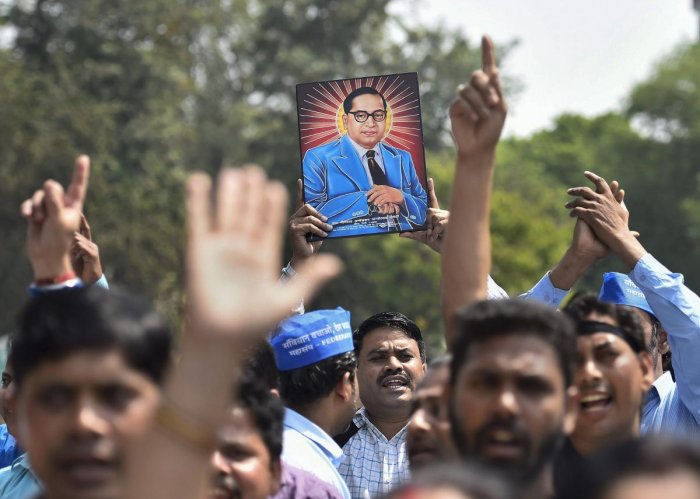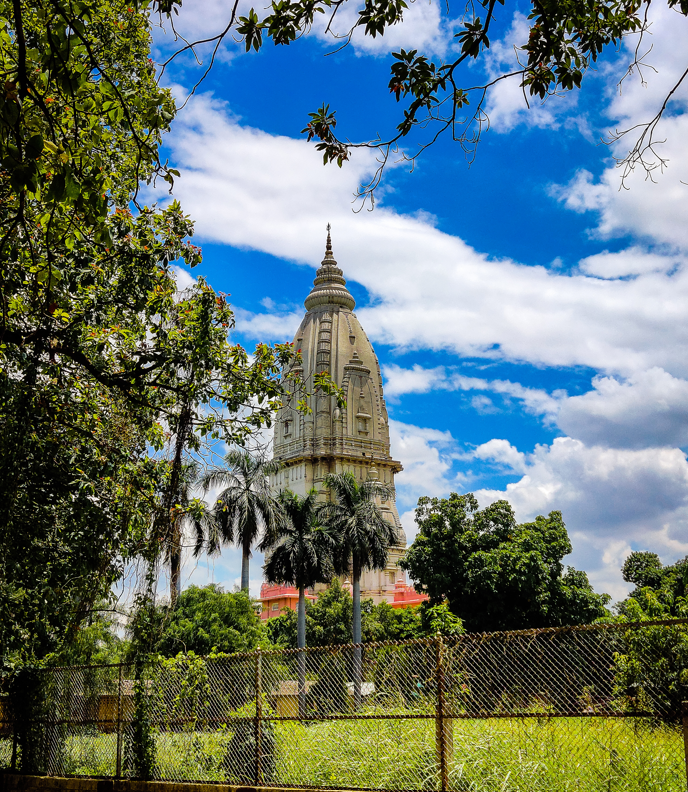Kashi Vishwanath: Years After the Constitution Came to Life, Sanatanist Resistance to Its Soul Persisted
The most revered of all the Jyotirlingas, the Kashi Vishwanath temple, located in the holy city of Banaras (now Varanasi) in Uttar Pradesh, also remained in the thrall of this pollution doctrine and continued to be out of bounds for Harijans. Throwing this temple open proved more challenging, in part, due to its custom of letting worshippers do ‘sparsh darshan’, that is, they could enter the sanctum sanctorum and touch the deity.
Naturally, the demand of the Harijans was that they be allowed to worship at the Kashi Vishwanath temple in the same manner as caste Hindus did, including the privilege of touching the deity. It was now their constitutional right.
The Sanatanist resistance in Banaras was spearheaded by Swami Hariharanand Saraswati, also known as Swami Karpatri Maharaj, who had hit the national headlines while leading a political movement against the Ambedkar-piloted Hindu Code Bill. The Ram Rajya Parishad, a far-right Hindu party that had been founded by Karpatri in 1948, went on to win three seats in the first Lok Sabha elections in 1952.

Caste Pride: Battles for Equality in Hindu India by Manoj Mitta (Context, April 24, 2023)
In his pushback against temple entry, however, he needed to be subtler. There was already a general enactment against 'untouchability' in the state, the United Provinces Removal of Social Disabilities Act, 1947, which included an express provision for temple entry. According to Section 3(d) of the Act, ‘no person could prevent another from having access to any public temple or enjoying the advantages, facilities and privileges of any such temple to the extent the same were available to other Hindus’.
At the Kashi Vishwanath temple, however, all that the Harijans were allowed to see was the deity through a tiny aperture on one of the walls, which could be approached by an outer passage avoiding the main gate.
After the enactment of the 1947 law, it took almost seven years for the Harijans to muster the courage to protest against the blatant violation of their rights. They printed leaflets and posters declaring that they would march in procession to the temple and enter it on the afternoon of February 17, 1954.
Given that it was not legal any longer to block Harijans from entering the temple as such, the alternative that Karpatri came up with was a form of segregation right inside its premises. True to his religious conception of 'untouchability', his priority was to deny Harijans the option of 'sparsh darshan', the most palpable feature of Kashi Vishwanath. Karpatri proposed that, unlike caste Hindus, Harijans be prevented from accessing the sanctum sanctorum or garbhagriha.
In a meeting, the Sanatanists suggested that the aperture through which the Harijans were accustomed to having a glimpse of the deity should be ‘substantially enlarged' so that 'they could have a greater facility in having darshan’. To ensure that they did not stray into the garbhagriha, it was further decided ‘to meet the Harijans at the main door, called the 'singhadwar', of the temple and to conduct them to the window, now enlarged, and to let them have 'darshan' of the sacred deity from that place in accordance with the old custom’.
The temple-entry movement in Banaras
The discourse on 'untouchability' had travelled a long way from Madura (now Madurai) in 1939 to Banaras in 1954. The range of political, legal and social changes in the intervening period were reflected in the agency acquired by the Harijans. The temple-entry movement in Banaras was led by legislators from their own community.
Also read: Even After a Century, Water Is Still the Marker of India’s Caste Society
Sadly, there was no corresponding progress in the thinking of the Sanatanists. They could not come to terms with the idea of parity between caste Hindus and Harijans, or abide the presence of the latter in the sanctum sanctorum of the Banaras temple. But the law was now on the side of the victims, at least in theory. So, unlike in the Madura of 1939, the opponents of temple entry were liable to fall foul of the law in the Banaras of 1954.
As recorded in a high court judgment, related to the Vishwanath temple's entry, this is what happened: a batch of Harijans, led by a Congress legislator from the community, Bechan Ram, arrived as scheduled at the main gate on February 17, 1954. Under the gaze of the district and police authorities, the Sanatanists led by Karpatri greeted the procession with garlands and ‘invited’ them to have 'darshan' of the deity ‘from the window or aperture now enlarged for them’. The court attempted to ascertain whether those Harijans were allowed to enter through the main gate to reach that aperture.
While the Sanatanists claimed that the Harijans had not been ‘stopped from entering through the main gate’, the State asserted that they had been ‘refused entrance… through the singhadwar (the main gate)'. Weighing the conflicting versions that had been given under oath, the high court found that ‘the Harijans could not, uninterrupted, have access to the temple through the main gate… because the Sanatanists, in particular the petitioners, were at the scene to obstruct their entry’.
They had not backed down even after the city magistrate warned them on the spot that ‘not allowing the Harijans to have access to the temple through the main gate would be an offence’.
The ploy of appearing to comply with the law (greeting Harijans with garlands) without compromising on their pious prejudice (not letting them enter through the main gate) clearly went awry. In a bid to ‘smoothen the way of the Harijans’, the city magistrate ordered the Sanatanists ‘to clear out of the temple’ and instructed the police ‘to take them in custody’ for violating the law.
Despite these arrests, the Sanatanists still had their way – not only were the Harijans denied their right to enter alongside other worshippers, once again, they were allowed darshan only through the aperture, which was now mercifully a little bigger than before.

Swami Karpatri Maharaj had led a political movement against the Ambedkar-piloted Hindu Code Bill. Photo: PTI
Also read: In Puri, God May Treat Sanitation Workers as ‘Equal’, but People Still Don’t
The hope of unopposed entry
The showdown made front-page news the next day. ‘Apprehending breach of peace, the police arrested today 30 persons, including Swami Karpatriji, leader of the Ram Rajya Parishad, who had been blocking the entrance to the temple of Vishwanath to prevent the entry of a batch of Harijans… The Harijan group, however, did not enter the temple and viewed the deity through the window of the outer wall.’
The law enforcement machinery, walking a tightrope, did not facilitate the entry of Harijans in the temple despite the arrests of its opponents.
Meanwhile, Karpatri played the martyr. He and his followers refused to seek bail, even when it was offered to them at the police station. As the high court put it, ‘The petitioners were told that they could be enlarged on bail in the event of their furnishing such bail, but they refused to give bail... [and] they were sent to jail custody by an order of the city magistrate, sometime on the night of February 17, 1954.’
From jail, Karpatri and his followers challenged the constitutionality of the law under which they had been arrested. The Allahabad high court ruled on March 16, 1954 that the 1947 UP law was protected by Article 25(2)(b) of the Constitution, saying, ‘This law only provided for the removal of these distinctions which caste Hindus enforced on the Harijans in respect of, among other matters, entry of Harijans in temples on the same footing as caste Hindus’.
While it upheld the substantive grounds on which they had been arrested, the high court ordered the release of Karpatri and his followers from what was by then a month-long detention in jail. The high court upheld their additional contention that the arrest was illegal due to procedural violations, such as the failure of the police to produce them before a magistrate within 24 hours.
Feeling vindicated by his release, the leader of the Ram Rajya Parishad resumed his campaign to save Kashi Vishwanath from being "polluted" by members belonging to the lower caste community.

Kashi Vishwanath temple at BHU Varanasi. Photo: Unsplash
Karpatri focused once again on preventing them from entering the sanctum sanctorum and touching the Jyotirlinga. On their part, the Harijans were equally determined to assert their right to do everything that other devotees were allowed to do in that temple. Their fresh temple entry plan was to go in batches for four days, starting on the festival of Ram Navami, due on April 11.
The negotiations that followed led to a loose understanding between all the stakeholders. On the one hand, it was agreed that ‘though the pandits would not give their formal consent to the entry of Harijans as it was against the shastras, they would not obstruct them if they entered the temple’. On the other hand, it was agreed that ‘Harijans would go to the temple in an ordinary way without taking out processions’. But the hope of unopposed entry died down two days before the festival.
The Harijans expressed misgivings about the proposal of slipping inside the temple unobtrusively. One of their leaders, Congress legislator Ram Lakhan, declared that unless Harijans went to the temple in a procession, their right to enter the temple would not be accepted. Reviving the original plan of going in batches for four days, starting on Ram Navami, Ram Lakhan and three other Harijan legislators announced that one of them would lead the procession on each of those days.
However, on the next day, a judicial order, restraining them, was issued, in the teeth of the law and the constitution.
On a suit filed by a couple of Sanatanists, the city munsif of Banaras, Rajnikant Srivastava, issued an interim injunction on April 10, 1954, restraining ‘some Harijan leaders and the Harijan community from entering the Vishwanath Temple and touching the idol of Vishwanath on April 11 and the subsequent days’.
The plaintiff contended that ‘the shastras did not permit the Antyaj to enter the temple and touch the deity’. On the basis of this contention, Srivastava granted an interim injunction invoking the principle of balance of convenience. ‘I think the opposite party will not be put to irreparable loss or inconvenience if they are restrained from entering the temple and touching the idol of Vishwanath,’ the order said.
Even four years after the formation of the Republic of India, the court appeared to have not realised that the shastras had been superseded by the constitution.
This piece is extracted from the book Caste Pride: Battles for Equality in Hindu India by Manoj Mitta published under ‘Context’. The book is available for pre-order from today, April 14.
This article went live on April fourteenth, two thousand twenty three, at zero minutes past six in the morning.The Wire is now on WhatsApp. Follow our channel for sharp analysis and opinions on the latest developments.




